On View
What Do Today’s Surveillance Systems Have to Do With the Riddle of the Sphinx? Just Ask Artist Marguerite Humeau
In this week's edition of Origin Story, we ask the young art star about her contemporary twist on the sphinx.
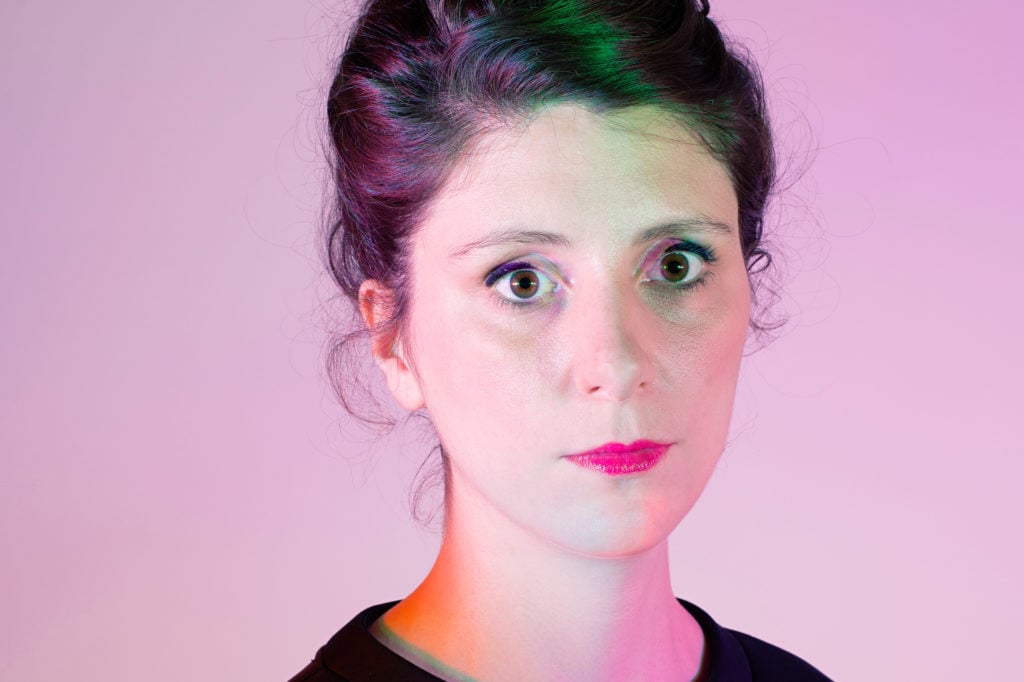
In this week's edition of Origin Story, we ask the young art star about her contemporary twist on the sphinx.

Hili Perlson

Marguerite Humeau knows we are being watched. Lately, the French artist has been using cutting-edge scientific research to create extraordinary, uncanny installations that remind us that we are being monitored by architecture and technology everywhere we go, from the office to the airport.
The concern with surveillance is recent, but it grows out of the London-based artist’s deeply researched inquiries on the meeting points of science, technology, and archaeology. These have taken the form of clinical-looking sound sculptures that speculate on the end of man, or imagine parallel evolutionary developments where prehistoric animals, mythical creatures, and other sentient beings have language and agency.
Such works have landed Humeau a slew of exhibitions in major institutions in the short five years since she graduated from London’s Royal College of Art, including solo shows at the Palais de Tokyo and Nottingham Contemporary. Her work was also featured in the Moscow Young Art Biennial (where she won a major award), Manifesta 11, and Megacity in Seoul, to name a few. In January, she won this year’s $100,000 Zurich Art Prize.
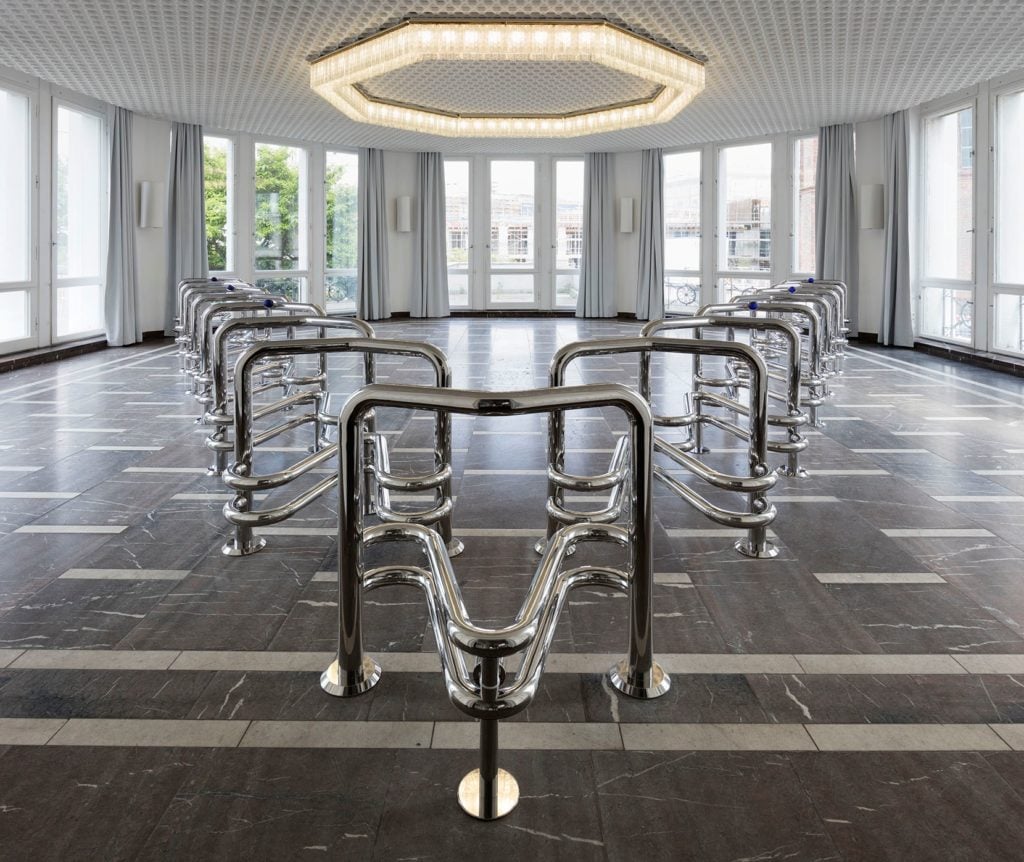
Marguerite Humeau, “Riddles”, Installation view at Schinkel Pavillon, Berlin.
Humeau’s latest body of work, titled “RIDDLES,” unspools across five shows this year: On New York’s High Line, at New York’s CLEARING gallery, at Berlin’s Schinkel Pavillon, at Haus Konstruktiv in Zürich, and at an institution outside Paris.
The Schinkel Pavillon dedicated its entire octagonal upper-level space to one massive work from the series: A v-shaped maze of steel gates that emit a droning sound as the viewer approaches. Cool-looking and as alienating as an airport security gate, it is not clear at first whether one should access the installation, walk through it, or try to steer clear of its blue, camera-like knobs.
We spoke to the artist about how—and why—she made it.
How did you develop the sphinx for Berlin? And how is it different to the works that were on view in New York?
“RIDDLES” is unfolding in five different chapters in 2017: On the High Line, sphinx “Joachim” has been engineered to guard planet Earth and protect it from mankind. Equipped with motion detectors, it roars as an alarm every time it senses a human presence. It is also equipped with “raptors”—sourced from an anti-climbing security systems website—cast in artificial human skin, and human motion detectors.
For Berlin’s Schinkel Pavillon, I have been on a quest to resuscitate the sphinx in our contemporary era. In the installation there, the sphinx consists of a complex network of meandering metal gates equipped with sound-emitting tools and glass eyes. The gates cross-communicate using radio signals. The installation performs a bizarre symphony of spinning lights and metal clicks; one hears bones cracking in the background.
It activates itself with human presence but has no other purpose other than to perform for itself. It does not scan, protect, monitor, or archive. The system has been accelerated, short-circuited, and as a result, emptied of its meaning. One question behind this show was, What would be the most abstract form of a sphinx today? The horror is contained, never revealing its true name.
In the last two chapters, yet to come, the sphinx has absorbed humankind and is protecting Earth against potential human survivors. There will be poisonous plants, fleshy flowers and bloody bushes…
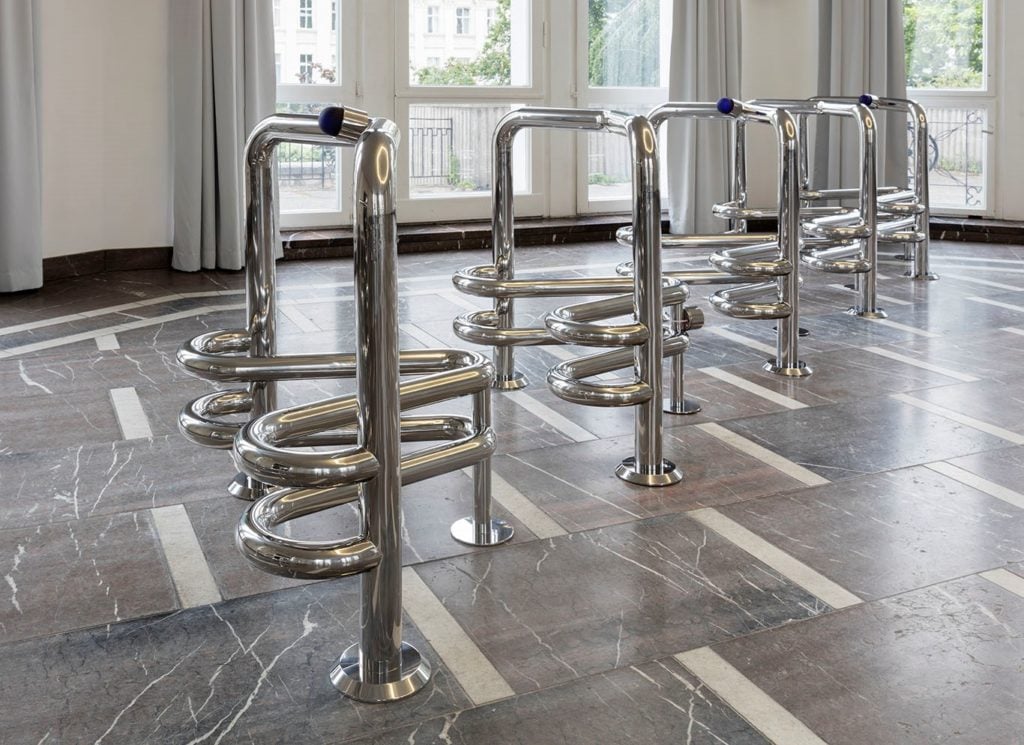
Marguerite Humeau, “Riddles”, Installation view at Schinkel Pavillon, Berlin.
How did you arrive at the connection between the figure of the sphinx adorning city gates and today’s cutting-edge security and surveillance apparatus, which is at the center of your latest body of work?
“RIDDLES” starts with the hypothesis that security protocols today might be the direct biological descendants to the figure of the sphinx in ancient histories. A mythical creature with the head of a human and the body of a lion, and sometimes the wings of a bird, the sphinx is noted for devouring anyone unable to answer its riddle. Security protocols seem to have the same ambiguous function today: They protect and guard borders—but by scanning them, they also capture humans and devour their intimacy.
I went on an epic quest to try to understand the exact origins of the sphinx. I started by analyzing early representations of war such as the Stele of the Vultures (2,600 BC) or the Battlefield Palette. Did the sphinx figure originate in ancient wars?
Another hypothesis comes from the observation that lions and vultures are some of the only scavengers, i.e. eaters of human flesh. Maybe early humans, who could be devoured by wild animals, invented the sphinx as a hybrid of their worst predators? This hybrid would inspire fear and terror while acting as a godly protector. This is the starting point for my shows opening in October in France and Zürich simultaneously.
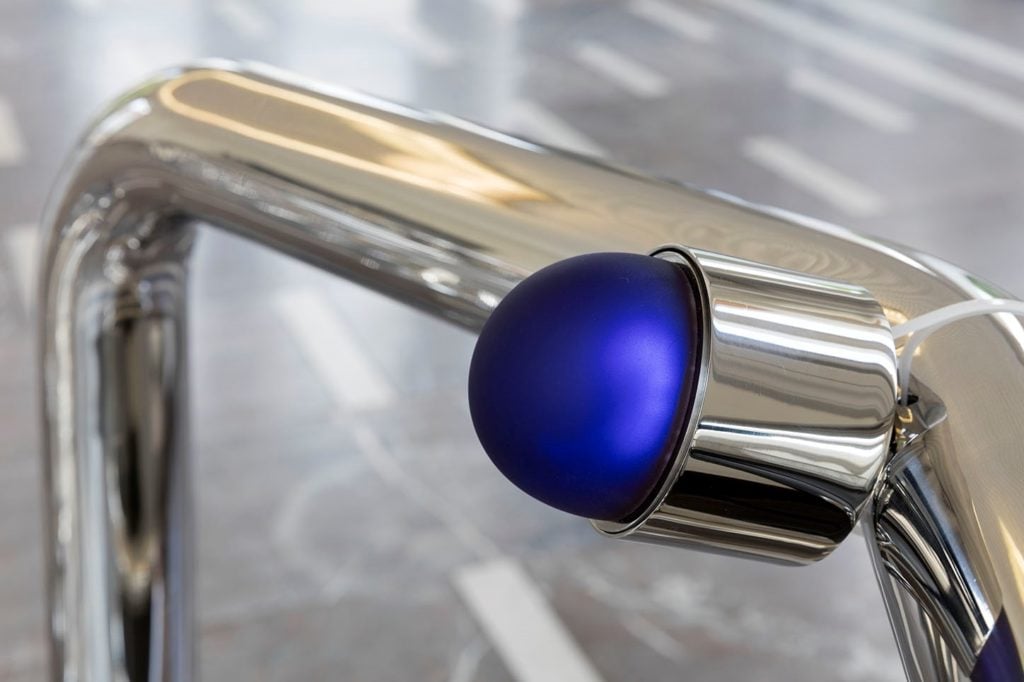
Marguerite Humeau, “Riddles” (detail), Installation view at Schinkel Pavillon, Berlin.
At Schinkel Pavillon, the viewer experiences the work on several different levels: visual, immersive, aural, and even from outside the pavilion’s windows, as an architectural element. Do you design the artwork or an exhibition with the movement of the viewers in mind?
From a general point of view, the design of presence and of experience is at the core of my practice. I even have an in-house “studio architect,” Juliette Rambaud, whose background is in exhibition design. At the Schinkel Pavillon, the sphinx has become completely abstract: It is a process, a mysterious protocol rather than a physical figure. I wanted to choreograph the movement of human flesh in space. (The subtitle for the show is “Jaws.”)
This show was quite specific as I decided to produce a series of 15 gates, and that we would decide in situ how to arrange them. (This is not normally how I work.)
The gates are like bones or vertebrae, they also look like locks of a Chinese mind game. They have been designed with a mirror polish to look like liquid mercury, fleshy metal. We finally decided to arrange them as a V, like an army or a flock of birds, or maybe a strange mythical beast in movement, running towards you as you come into the show.
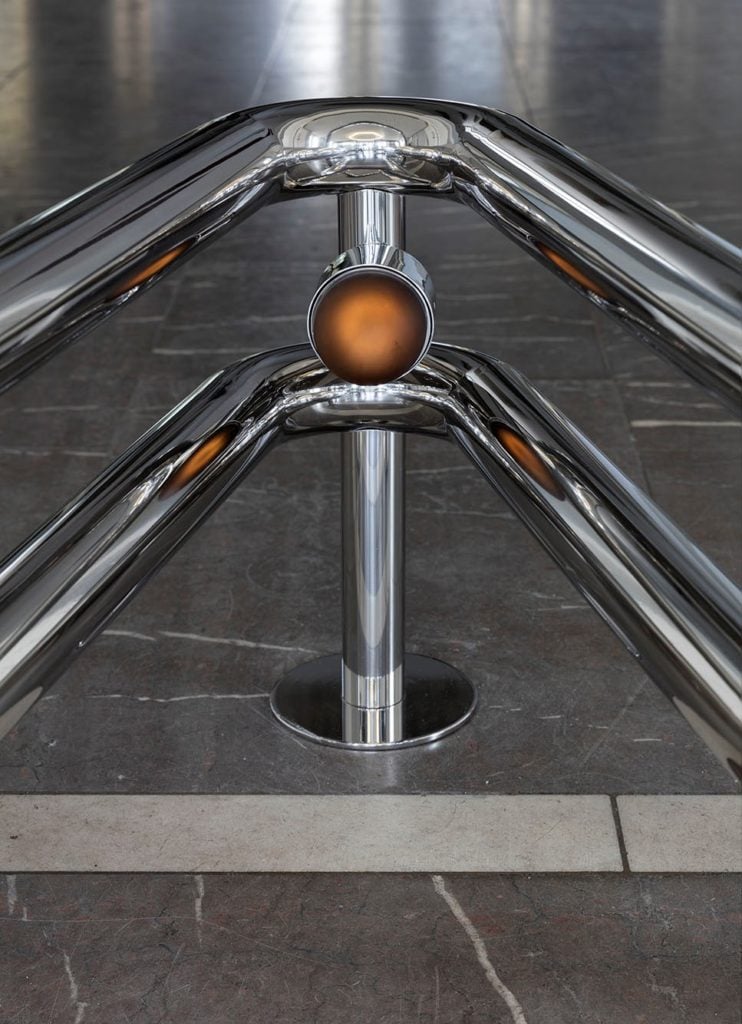
Marguerite Humeau, “Riddles” (detail), Installation view at Schinkel Pavillon, Berlin.
Did you collaborate or do research with security professionals, programmers or other specialists for this body of work?
I worked mostly with historians and archaeologists in the first part of the research, and then had discussions with security professionals, like companies selling “raptors,” anti-human scaling devices, and those who construct gates and associated softwares that are used in airports. I went to visit gate fabricators, etc. I became completely obsessed with collecting “abstract,” contemporary sphinx figures.
From a pure sculptural point of view, I was also interested, for this specific show, in removing all the unnecessary “flesh” to only keep the skeleton, jumping towards pure abstraction.
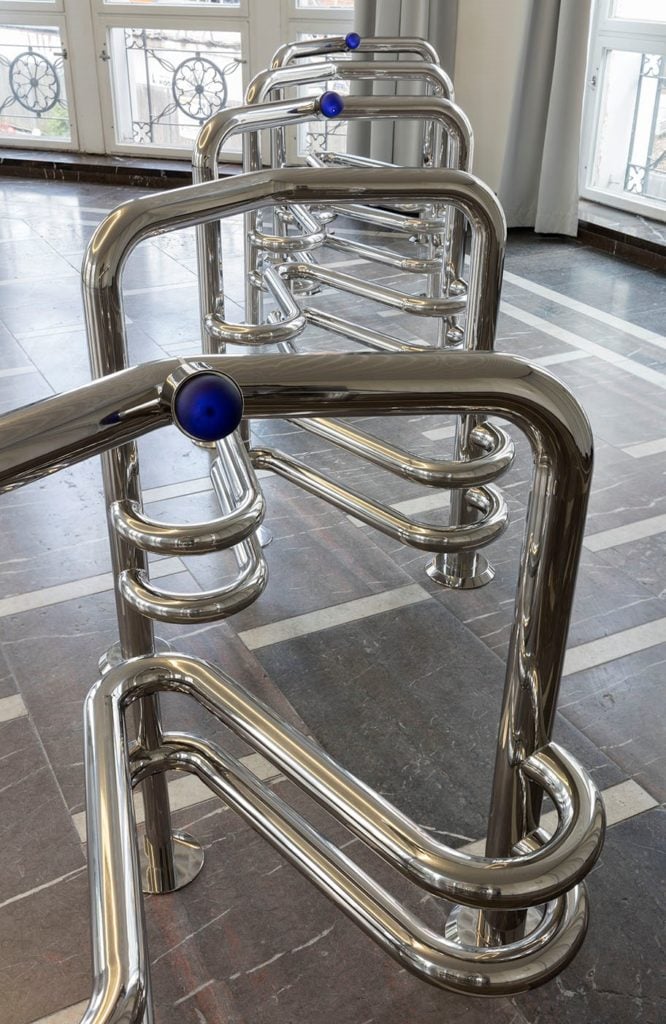
Marguerite Humeau, “Riddles” (detail), Installation view at Schinkel Pavillon, Berlin.
As surveillance and security standards have become an inevitable part of our global situation, there is no way to imagine life without them. We’re trapped, spied on by devices of our own making. What aspect of this reality does your work seek to explore? After all, there’s presumably no return.
For the show at CLEARING I created a piece entitled “Digital Desert.” The Digital Desert is a pattern that has been designed by the US army to hide humans from the drone’s (or sphinx’s) eyes. This means that we have built sphinx-like machines that we now have to hide from. It made me think that soon, the drones will try to hide from us. So I asked a friend of mine, Camille Thiéry, to design a camouflage pattern to conceal drones.
I think the horror does not come from darkness anymore, it comes from the fact that we are constantly exposed to the light, being constantly visible. Will we still be able to hide?
“Origin Story” is a column in which we examine the backstory of an individual work of art. Marguerite Humeau’s “Riddles” is on view at the Schinkel Pavillon in Berlin until July 30.